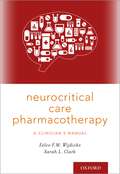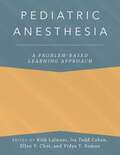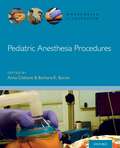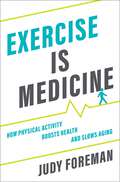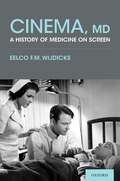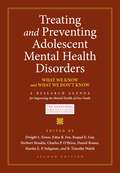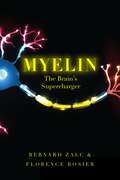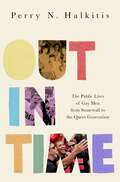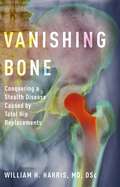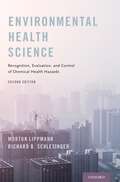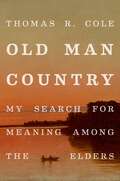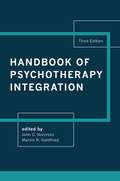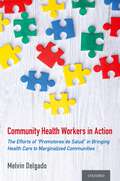- Table View
- List View
Neurocritical Care Pharmacotherapy: A Clinician's Manual
by Eelco F.M. Wijdicks Sarah L. ClarkNeurocritical Care Pharmacotherapy: A Clinican's Guide is a practical, succinct but comprehensive pharmacy handbook provides up-to-date clinical guidance on the effective selection, prescription, and usage of neurocritical care drugs for patients with acute neurologic illnesses. The treatment of the critically ill neurologic patient is often difficult, specialized, and includes drugs infrequently used in other intensive care units such as antiepileptic drugs, osmotic agents or acute immunotherapy such as intravenous immunoglobulin and plasma exchange. This text discusses choosing the right combination of drugs; how to correctly prescribe and administer the drugs; how to monitor drug efficacy and side effects; how neurocritical care drugs interact with other medications; and comprehensive coverage of current treatment options. Key Feature of this Manual Include · A brief discussion of the basic pharmacology of each neurocritical drug, with an emphasis on how to select and use these drugs in multiple clinical contexts. · 150 drugs accompanied by a diagram for quick comprehension and drug administration guides. · Unique blending of expertise of neurointensivist with a critical care pharmacist to provide a vital resource for both specialities · References for further reading that are oriented toward utility in clinical practice.
Neurocritical Care Pharmacotherapy: A Clinician's Manual
by Eelco F.M. Wijdicks Sarah L. ClarkNeurocritical Care Pharmacotherapy: A Clinican's Guide is a practical, succinct but comprehensive pharmacy handbook provides up-to-date clinical guidance on the effective selection, prescription, and usage of neurocritical care drugs for patients with acute neurologic illnesses. The treatment of the critically ill neurologic patient is often difficult, specialized, and includes drugs infrequently used in other intensive care units such as antiepileptic drugs, osmotic agents or acute immunotherapy such as intravenous immunoglobulin and plasma exchange. This text discusses choosing the right combination of drugs; how to correctly prescribe and administer the drugs; how to monitor drug efficacy and side effects; how neurocritical care drugs interact with other medications; and comprehensive coverage of current treatment options. Key Feature of this Manual Include · A brief discussion of the basic pharmacology of each neurocritical drug, with an emphasis on how to select and use these drugs in multiple clinical contexts. · 150 drugs accompanied by a diagram for quick comprehension and drug administration guides. · Unique blending of expertise of neurointensivist with a critical care pharmacist to provide a vital resource for both specialities · References for further reading that are oriented toward utility in clinical practice.
Pediatric Anesthesia: A Problem-Based Learning Approach (Anaesthesiology: A Problem-Based Learning Approach)
Linking existing knowledge to new knowledge by presenting it in the form of a case or a problem is a popular and effective educational approach resulting in better retention of the knowledge and improved ability to apply that knowledge to solve real problems. This problem-based learning (PBL) method was introduced into medical education at McMaster University in Ontario, Canada, in 1969. Since then it has been widely incorporated into secondary, undergraduate, and graduate education in a variety of disciplines worldwide. This new volume for the Anesthesiology Problem-Based Learning series reviews pediatric anesthesia utilizing the PBL approach. Each chapter deals with conditions and problems in pediatric anesthesia practice presented as a case stem with questions to encourage critical thinking, followed by an evidence-based discussion and multiple-choice questions for self-assessment. Cases were carefully selected to present a broad systems-based tour of commonly encountered clinical cases in pediatric anesthesia. The book can be used to review an upcoming clinical case or as a PBL tool. The 'Stem Case and Key Questions' and 'Discussion' sections can serve as the basis for interactive learning experiences for study groups or as a broad yet in-depth clinical review of the subspecialty for the individual learner. Self-assessment questions can be used as a measure of knowledge acquisition or simply as a question bank to prepare for examinations.
Pediatric Anesthesia: A Problem-Based Learning Approach (Anaesthesiology: A Problem Based Learning Approach)
by Kirk Lalwani, Ira Todd Cohen, Ellen Y. Choi and Vidya T. RamanLinking existing knowledge to new knowledge by presenting it in the form of a case or a problem is a popular and effective educational approach resulting in better retention of the knowledge and improved ability to apply that knowledge to solve real problems. This problem-based learning (PBL) method was introduced into medical education at McMaster University in Ontario, Canada, in 1969. Since then it has been widely incorporated into secondary, undergraduate, and graduate education in a variety of disciplines worldwide. This new volume for the Anesthesiology Problem-Based Learning series reviews pediatric anesthesia utilizing the PBL approach. Each chapter deals with conditions and problems in pediatric anesthesia practice presented as a case stem with questions to encourage critical thinking, followed by an evidence-based discussion and multiple-choice questions for self-assessment. Cases were carefully selected to present a broad systems-based tour of commonly encountered clinical cases in pediatric anesthesia. The book can be used to review an upcoming clinical case or as a PBL tool. The 'Stem Case and Key Questions' and 'Discussion' sections can serve as the basis for interactive learning experiences for study groups or as a broad yet in-depth clinical review of the subspecialty for the individual learner. Self-assessment questions can be used as a measure of knowledge acquisition or simply as a question bank to prepare for examinations.
Pediatric Anesthesia Procedures (Anesthesia Illustrated)
by Keith J. RuskinThere is a decreased tolerance for error when pediatric patients undergo medical procedures. It is, therefore, important to accomplish procedures as quickly and accurately as possible. Pediatric Anesthesia Procedures is designed to provide rapid access to information in order to solve a clinical problem as it is occurring. Its pictorial, highly visual format will allow anesthesiologists and other clinicians to review and 'see' the procedures during planning stages, making it a practical resource to keep in the operating room for quick and easy reference during time-pressured situations. This will make it especially useful for practitioners doing procedures that they perform infrequently-or must perform for the first time during an emergent or urgent situation. The chapters within cover a wide variety of basic and advanced pediatric anesthesia procedures and provide generously illustrated step-by-step guidelines for performing them. Each is introduced with an accessible description, followed by a variety of high-quality graphic images-including detailed photographs, magnetic resonance images, computed tomography images, and ultrasound images-and detailed instructions.
Pediatric Anesthesia Procedures (Anesthesia Illustrated)
by Keith J. RuskinThere is a decreased tolerance for error when pediatric patients undergo medical procedures. It is, therefore, important to accomplish procedures as quickly and accurately as possible. Pediatric Anesthesia Procedures is designed to provide rapid access to information in order to solve a clinical problem as it is occurring. Its pictorial, highly visual format will allow anesthesiologists and other clinicians to review and 'see' the procedures during planning stages, making it a practical resource to keep in the operating room for quick and easy reference during time-pressured situations. This will make it especially useful for practitioners doing procedures that they perform infrequently-or must perform for the first time during an emergent or urgent situation. The chapters within cover a wide variety of basic and advanced pediatric anesthesia procedures and provide generously illustrated step-by-step guidelines for performing them. Each is introduced with an accessible description, followed by a variety of high-quality graphic images-including detailed photographs, magnetic resonance images, computed tomography images, and ultrasound images-and detailed instructions.
Exercise is Medicine: How Physical Activity Boosts Health and Slows Aging
by Judy ForemanAging, despite its dismal reputation, is actually one of the great mysteries of the universe. Why don't we just reproduce, then exit fast, like salmon? Could aging just be one big evolutionary accident? Is senescence, the gradual falling apart of our bodies, at least partially avoidable? Can we extend the healthy lifespan and reduce the lingering, debilitating effects of senescence? In this book, investigative health journalist Judy Foreman suggests that we actually can, and the key element is exercise, through its myriad effects on dozens of molecules in the brain, the muscles, and other organs. It's no secret, of course, that exercise is good for you and that exercise can extend longevity. What Foreman uncovers through extensive research into evolutionary biology, exercise physiology, and the new field of geroscience is exactly why exercise is so powerful - the mechanisms now being discovered that account for the vast and varied effects of exercise all over the body. Though Foreman also delves into pills designed to combat aging and so-called exercise "mimetics," or pills that purport to produce the effects of exercise without the sweat, her resounding conclusion is that exercise itself is by far the most effective, and safest, strategy for promoting a long, healthy life. In addition to providing a fascinating look at the science of exercise's effects on the body, Foreman also provides answers to the most commonly asked practical questions about exercise.
Exercise is Medicine: How Physical Activity Boosts Health and Slows Aging
by Judy ForemanAging, despite its dismal reputation, is actually one of the great mysteries of the universe. Why don't we just reproduce, then exit fast, like salmon? Could aging just be one big evolutionary accident? Is senescence, the gradual falling apart of our bodies, at least partially avoidable? Can we extend the healthy lifespan and reduce the lingering, debilitating effects of senescence? In this book, investigative health journalist Judy Foreman suggests that we actually can, and the key element is exercise, through its myriad effects on dozens of molecules in the brain, the muscles, and other organs. It's no secret, of course, that exercise is good for you and that exercise can extend longevity. What Foreman uncovers through extensive research into evolutionary biology, exercise physiology, and the new field of geroscience is exactly why exercise is so powerful - the mechanisms now being discovered that account for the vast and varied effects of exercise all over the body. Though Foreman also delves into pills designed to combat aging and so-called exercise "mimetics," or pills that purport to produce the effects of exercise without the sweat, her resounding conclusion is that exercise itself is by far the most effective, and safest, strategy for promoting a long, healthy life. In addition to providing a fascinating look at the science of exercise's effects on the body, Foreman also provides answers to the most commonly asked practical questions about exercise.
Cinema, MD: A History of Medicine On Screen
by Eelco F.M. WijdicksCinema, MD follows the intersection of medicine and film and how filmmakers wrote a history of medicine over time. The narrative follows several main story lines: How did the portrayal of physicians, nurses, and medical institutions change over the years? What interested filmmakers, and which topics had priority? What does film's obsession with experiments and monstrosities reveal about medical ethics and malpractice? How could the public's perception of the medical profession change when watching these films on diseases and treatments, including palliative care and medical ethics? Are screenwriters, actors, and film directors channeling a popular view of medicine? Cinema, MD analyzes not only changing practices, changing morals, and changing expectations but also medical stereotypes, medical activism, and violations of patients' integrity and autonomy. Examining over 400 films with medical themes over a century of cinema, this book establishes the cultural, medical, and historical importance of the art form. Film allows us to see our humanity, our frailty, and our dependence when illness strikes. Cinema, MD provides uniquely new and fascinating insight into both film criticism and the history of medicine and has a resonance to the medical world we live in today.
Cinema, MD: A History of Medicine On Screen
by Eelco F.M. WijdicksCinema, MD follows the intersection of medicine and film and how filmmakers wrote a history of medicine over time. The narrative follows several main story lines: How did the portrayal of physicians, nurses, and medical institutions change over the years? What interested filmmakers, and which topics had priority? What does film's obsession with experiments and monstrosities reveal about medical ethics and malpractice? How could the public's perception of the medical profession change when watching these films on diseases and treatments, including palliative care and medical ethics? Are screenwriters, actors, and film directors channeling a popular view of medicine? Cinema, MD analyzes not only changing practices, changing morals, and changing expectations but also medical stereotypes, medical activism, and violations of patients' integrity and autonomy. Examining over 400 films with medical themes over a century of cinema, this book establishes the cultural, medical, and historical importance of the art form. Film allows us to see our humanity, our frailty, and our dependence when illness strikes. Cinema, MD provides uniquely new and fascinating insight into both film criticism and the history of medicine and has a resonance to the medical world we live in today.
Treating and Preventing Adolescent Mental Health Disorders: What We Know and What We Don't Know (Adolescent Mental Health Initiative)
by Daniel RomerSponsored by the Adolescent Mental Health Initiative of the Annenberg Public Policy Center (APPC) of the University of Pennsylvania and the Annenberg Foundation Trust at Sunnylands Trust, Treating and Preventing Adolescent Mental Health Disorders, Second Edition, provides a major update since the first edition in 2005. It addresses the current state of knowledge about the major mental health disorders that emerge during adolescence, including updated DSM-5 diagnostic criteria. Here, six commissions established by the APPC and the Sunnylands Trust pool their expertise on adolescent anxiety, schizophrenia, substance use disorders, depression and bipolar disorders, eating disorders, and suicidal behavior in sections that thoroughly define each disorder, outline and assess available treatments, discuss prevention strategies, and suggest a research agenda based on what we know and don't yet know about these various conditions. Two additional behavioral disorders-gambling and internet addiction--are covered in this second edition. As a meaningful counterpoint to its primary focus on mental illness, the volume also incorporates the latest research from a seventh commission--on positive youth development--which addresses how we can fully prepare young people to be happy and successful throughout their lives. Concluding chapters discuss overarching issues regarding the behavioral and mental health of adolescents: overcoming the stigma of mental illness, the research, policy, and practice context for the delivery of evidence-based treatments, and the development of a more robust agenda to advance adolescent health. Integrating the work of eminent scholars in both psychology and psychiatry, this work will be an essential volume for academics and practicing clinicians and will serve as a wake-up call to mental health professionals and policy makers alike about the state of our nation's response to the needs of adolescents with mental disorders.
Myelin: The Brain's Supercharger
by Bernard Zalc Florence RosierThe emergence of myelin 425 million years ago marked a turning point in evolution. Consider for a moment the invention of insulated wire, which allows for the transmission of electrical current. Functioning in a similar way, the membrane surrounding nerve fibers, or myelin, enables the remarkable acceleration of nerve impulses. Surprisingly, myelin occupies nearly half the volume of the human brain and is critical for our intellectual and motor performance. Without myelin, our thoughts and our movements would suffer overwhelming delays. We owe our reflexes to myelin: it is what makes us brake when a child dashes out onto the road, or snatch away a hand absent-mindedly placed on a burning hot stove. When damaged, myelin can lead to irreversible disability, cognitive decline, and sensory impairments. The study of myelin's role in the conduction of nerve impulses has led to a better understanding of several diseases including multiple sclerosis, Guillain-Barre syndrome, Charcot disease (ALS), and Niemann-Pick disease.
Myelin: The Brain's Supercharger
by Bernard Zalc Florence RosierThe emergence of myelin 425 million years ago marked a turning point in evolution. Consider for a moment the invention of insulated wire, which allows for the transmission of electrical current. Functioning in a similar way, the membrane surrounding nerve fibers, or myelin, enables the remarkable acceleration of nerve impulses. Surprisingly, myelin occupies nearly half the volume of the human brain and is critical for our intellectual and motor performance. Without myelin, our thoughts and our movements would suffer overwhelming delays. We owe our reflexes to myelin: it is what makes us brake when a child dashes out onto the road, or snatch away a hand absent-mindedly placed on a burning hot stove. When damaged, myelin can lead to irreversible disability, cognitive decline, and sensory impairments. The study of myelin's role in the conduction of nerve impulses has led to a better understanding of several diseases including multiple sclerosis, Guillain-Barre syndrome, Charcot disease (ALS), and Niemann-Pick disease.
Out in Time: The Public Lives of Gay Men from Stonewall to the Queer Generation
by Perry N. HalkitisThe civil rights of LGBTQ people have slowly yet steadily strengthened since the Stonewall Riots of June, 1969. Despite enormous opposition from some political segments and the catastrophic effects of the AIDS crisis, the last five decades have witnessed improvement in the conditions of the lives of LGBTQ individuals in the United States. As such, the realities and challenges faced by a young gay man coming of age and coming out in the 1960s is, in many profound ways, different from the experiences of a young gay man coming of age and coming out today. Out in Time explores the life experiences of three generations of gay men --the Stonewall, AIDS, and Queer generations-- arguing that while there are generational differences in the lived experiences of young gay men, each one confronts its own unique historical events, realities, and socio-political conditions, there are consistencies across time that define and unify the identity formation of gay men. Guided by the vast research literature on gay identity formation and coming out, the ideas and themes explored here are seen through the oral histories of a diverse set of fifteen gay men, five from each generation. Out in Time demonstrates how early life challenges define and shape the life courses of gay men, demarcating both the specific time-bound challenges encountered by each generation, and the universal challenges encountered by gay men coming of age across all generations and the conditions that define their lives.
Out in Time: The Public Lives of Gay Men from Stonewall to the Queer Generation
by Perry N. HalkitisThe civil rights of LGBTQ people have slowly yet steadily strengthened since the Stonewall Riots of June, 1969. Despite enormous opposition from some political segments and the catastrophic effects of the AIDS crisis, the last five decades have witnessed improvement in the conditions of the lives of LGBTQ individuals in the United States. As such, the realities and challenges faced by a young gay man coming of age and coming out in the 1960s is, in many profound ways, different from the experiences of a young gay man coming of age and coming out today. Out in Time explores the life experiences of three generations of gay men --the Stonewall, AIDS, and Queer generations-- arguing that while there are generational differences in the lived experiences of young gay men, each one confronts its own unique historical events, realities, and socio-political conditions, there are consistencies across time that define and unify the identity formation of gay men. Guided by the vast research literature on gay identity formation and coming out, the ideas and themes explored here are seen through the oral histories of a diverse set of fifteen gay men, five from each generation. Out in Time demonstrates how early life challenges define and shape the life courses of gay men, demarcating both the specific time-bound challenges encountered by each generation, and the universal challenges encountered by gay men coming of age across all generations and the conditions that define their lives.
Vanishing Bone: Conquering a Stealth Disease Caused by Total Hip Replacements
by William H. HarrisWhen dozens of holes appeared in a patient's femur alongside his hip prosthesis, experts were baffled as such a phenomenon had never been seen before. Over the first four decades of total hip surgery, the severe bone destruction multiplied, crippling many thousands of patients. Eventually identified as "periprosthetic osteolysis," this devastating disease affected over 1 million patients and was the leading cause of failure in total hip surgery. While total hip surgery dramatically reversed severe arthritis of the hip, the same operation simultaneously created a relentless 'particle generator' in the body. Ironically, in the effort to do good, doctors were simultaneously doing major harm. Vanishing Bone: Conquering a Stealth Disease Caused by Total Hip Replacements takes readers on a detective adventure in contemporary medical science, from the identification of the cause of the disease through the complex process of affecting its cure. Dr. William H. Harris and his colleagues played an important role in solving the mystery of this disease, pointing to its molecular biology, recognizing the unusual wear of the prostheses, and ultimately developing a new material for use in the manufacture of hip implants. With more than 6 million people walking on this stable, low-wear material, the disease has been virtually eliminated among those with total hip replacements worldwide. Diseases are rarely observed, revealed, and eliminated in one lifetime. Vanishing Bone tells the captivating story of one such disease through an engaging account of scientific and medical innovation.
Vanishing Bone: Conquering a Stealth Disease Caused by Total Hip Replacements
by William H. HarrisWhen dozens of holes appeared in a patient's femur alongside his hip prosthesis, experts were baffled as such a phenomenon had never been seen before. Over the first four decades of total hip surgery, the severe bone destruction multiplied, crippling many thousands of patients. Eventually identified as "periprosthetic osteolysis," this devastating disease affected over 1 million patients and was the leading cause of failure in total hip surgery. While total hip surgery dramatically reversed severe arthritis of the hip, the same operation simultaneously created a relentless 'particle generator' in the body. Ironically, in the effort to do good, doctors were simultaneously doing major harm. Vanishing Bone: Conquering a Stealth Disease Caused by Total Hip Replacements takes readers on a detective adventure in contemporary medical science, from the identification of the cause of the disease through the complex process of affecting its cure. Dr. William H. Harris and his colleagues played an important role in solving the mystery of this disease, pointing to its molecular biology, recognizing the unusual wear of the prostheses, and ultimately developing a new material for use in the manufacture of hip implants. With more than 6 million people walking on this stable, low-wear material, the disease has been virtually eliminated among those with total hip replacements worldwide. Diseases are rarely observed, revealed, and eliminated in one lifetime. Vanishing Bone tells the captivating story of one such disease through an engaging account of scientific and medical innovation.
Environmental Health Science: Recognition, Evaluation, and Control of Chemical Health Hazards
by Morton Lippmann Richard B. SchlesingerSince the publication of the first edition of ENVIRONMENTAL HEALTH SCIENCE, preventing and treating acute and chronic disease caused by exposure to chemical health hazards has become even more central to the practice of public health. This fully revised and updated edition introduces students and practitioners to the concepts and terminology from chemistry, ecology, toxicology, and engineering necessary for identifying the sources of environmental contaminants; quantifying environmental levels and human exposures; and preventing and remediating environmental health hazards. Liberal use of figures and tables allows readers to visualize complex scientific phenomena and to understand their effects on every aspect of the environment from cells to entire ecosystems. Authored by two of the foremost educators, investigators, and practitioners in this increasingly important discipline, the new edition of ENVIRONMENTAL HEALTH SCIENCE is an essential resource for students and practitioners in public health; civil, environmental, and chemical engineers; policy makers; science journalists; and anyone else committed to promoting human health and the health of our environment.
Environmental Health Science: Recognition, Evaluation, and Control of Chemical Health Hazards
by Morton Lippmann Richard B. SchlesingerSince the publication of the first edition of ENVIRONMENTAL HEALTH SCIENCE, preventing and treating acute and chronic disease caused by exposure to chemical health hazards has become even more central to the practice of public health. This fully revised and updated edition introduces students and practitioners to the concepts and terminology from chemistry, ecology, toxicology, and engineering necessary for identifying the sources of environmental contaminants; quantifying environmental levels and human exposures; and preventing and remediating environmental health hazards. Liberal use of figures and tables allows readers to visualize complex scientific phenomena and to understand their effects on every aspect of the environment from cells to entire ecosystems. Authored by two of the foremost educators, investigators, and practitioners in this increasingly important discipline, the new edition of ENVIRONMENTAL HEALTH SCIENCE is an essential resource for students and practitioners in public health; civil, environmental, and chemical engineers; policy makers; science journalists; and anyone else committed to promoting human health and the health of our environment.
Old Man Country: My Search for Meaning Among the Elders
by Thomas R. ColeWe aspire to live in a country where old men are celebrated as vital elders but not demeaned if they become ill and dependent. We aspire to maintain health as well as maintain dignity and fulfillment in frailty. Old Man Country helps readers see and imagine these possibilities for themselves. The book follows the journey of a writer in search of wisdom, as he encounters twelve distinguished American men over 80 -- including Paul Volcker, the former head of the Federal Reserve, and Denton Cooley, the world's most famous heart surgeon. In these and other intimate conversations, the book explores and honors the particular way that each man faces four challenges of living a good old age: Am I still a man? Do I still matter? What is the meaning of my life? Am I loved? Readers will come to see how each man -- even the most famous -- faces universal challenges. Personal stories about work, love, sexuality, and hope mingle with stories about illness, loss and death. This book will strengthen each of us as we and our loved ones anticipate and navigate our way through the passages of old age.
Old Man Country: My Search for Meaning Among the Elders
by Thomas R. ColeWe aspire to live in a country where old men are celebrated as vital elders but not demeaned if they become ill and dependent. We aspire to maintain health as well as maintain dignity and fulfillment in frailty. Old Man Country helps readers see and imagine these possibilities for themselves. The book follows the journey of a writer in search of wisdom, as he encounters twelve distinguished American men over 80 -- including Paul Volcker, the former head of the Federal Reserve, and Denton Cooley, the world's most famous heart surgeon. In these and other intimate conversations, the book explores and honors the particular way that each man faces four challenges of living a good old age: Am I still a man? Do I still matter? What is the meaning of my life? Am I loved? Readers will come to see how each man -- even the most famous -- faces universal challenges. Personal stories about work, love, sexuality, and hope mingle with stories about illness, loss and death. This book will strengthen each of us as we and our loved ones anticipate and navigate our way through the passages of old age.
Handbook of Psychotherapy Integration
Hailed by one reviewer as "the bible of the integration movement," the inaugural edition of Handbook of Psychotherapy Integration was the first compilation of the early integrative approaches to therapy. Since its publication psychotherapy integration has grown into a mature, empirically supported, and international movement, and the current edition provides a comprehensive review of what has been done. Reflecting the considerable advances in the field since the previous edition's release in 2005, this third edition of Handbook of Psychotherapy Integration continues to be the state-of-the-art description of psychotherapy integration and its clinical practices by some of its most distinguished proponents. Six chapters new to this edition describe growing areas of psychotherapy research and practice: common factors therapy, principle-based integration, integrative psychotherapy with children, mixing psychotherapy and self-help, integrating research and practice, and international themes. The latter two of these constitute contemporary thrusts in the integration movement: blending research and practice, and recognizing its international nature. Also closely examined are the concepts, history, training, research, global themes, and future of psychotherapy integration. Each chapter includes a new section on cultural considerations, and an emphasis is placed throughout the volume on outcome research. Charting the remarkable evolution of psychotherapy integration itself, the third edition of this Handbook will continue to prove invaluable to practitioners, researchers, and students alike.
HANDB PSYCHOTHERAPY INTEGRATION 3E C
by John C. Norcross and Marvin R. GoldfriedHailed by one reviewer as "the bible of the integration movement," the inaugural edition of Handbook of Psychotherapy Integration was the first compilation of the early integrative approaches to therapy. Since its publication psychotherapy integration has grown into a mature, empirically supported, and international movement, and the current edition provides a comprehensive review of what has been done. Reflecting the considerable advances in the field since the previous edition's release in 2005, this third edition of Handbook of Psychotherapy Integration continues to be the state-of-the-art description of psychotherapy integration and its clinical practices by some of its most distinguished proponents. Six chapters new to this edition describe growing areas of psychotherapy research and practice: common factors therapy, principle-based integration, integrative psychotherapy with children, mixing psychotherapy and self-help, integrating research and practice, and international themes. The latter two of these constitute contemporary thrusts in the integration movement: blending research and practice, and recognizing its international nature. Also closely examined are the concepts, history, training, research, global themes, and future of psychotherapy integration. Each chapter includes a new section on cultural considerations, and an emphasis is placed throughout the volume on outcome research. Charting the remarkable evolution of psychotherapy integration itself, the third edition of this Handbook will continue to prove invaluable to practitioners, researchers, and students alike.
Community Health Workers in Action: The Efforts of "Promotores de Salud" in Bringing Health Care to Marginalized Communities
by Melvin DelgadoCommunity Health Workers in Action proposes support and expansion of the role of community health workers in meeting the health needs of marginalized groups in United States cities (although their potential reach is not limited to any one group or geographical section). Given the health inequities that continue to touch the lives of millions of people of color across the country, these professionals' efforts--which translate to innovative, community-centered responses designed to reach particularly vulnerable populations--are quite timely. In order to truly understand the topic of health care, one must first explore its historical contexts, socio-cultural factors, and the ways in which values play a critical role in shaping a worldview of the right to quality care. This book offers readers a window into the dynamic field that continues to expand in highly creative and cost-effective ways, which ultimately shape one major piece of the complicated puzzle that is health care in America.
Community Health Workers in Action: The Efforts of "Promotores de Salud" in Bringing Health Care to Marginalized Communities
by Melvin DelgadoCommunity Health Workers in Action proposes support and expansion of the role of community health workers in meeting the health needs of marginalized groups in United States cities (although their potential reach is not limited to any one group or geographical section). Given the health inequities that continue to touch the lives of millions of people of color across the country, these professionals' efforts--which translate to innovative, community-centered responses designed to reach particularly vulnerable populations--are quite timely. In order to truly understand the topic of health care, one must first explore its historical contexts, socio-cultural factors, and the ways in which values play a critical role in shaping a worldview of the right to quality care. This book offers readers a window into the dynamic field that continues to expand in highly creative and cost-effective ways, which ultimately shape one major piece of the complicated puzzle that is health care in America.
